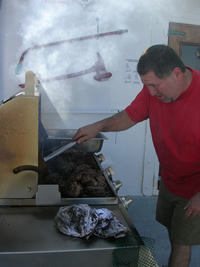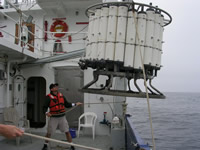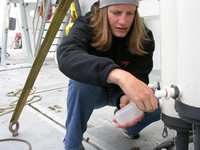


|
The Project
|
August 23, 2005
Nutrients in the Ocean, in our Food, and for our Plants It’s foggy and cold out in the Monterey Bay on this Tuesday morning. The two cooks, Eddie Lograsso and Mark Smith have been busy preparing the breakfast meal long before the science team comes down to breakfast at 7:15. Eddie and Mark prepare three meals each day for everybody on the ship. Meals are scheduled at regular times: 7:15, 11:15, and at 5:15. Leftovers are stored for those who miss the regular mealtimes. Mark started cooking while in the US Navy. He joined the Navy right after high school. “It’s an interesting story because you are asked if you plan to go to college or not and I said, no I don’t want to go to college. So, I became a cook. I should have gone to college but at that time I didn’t know how important it was to get an education. I like my job with the University. I like to cook and travel around on the ocean.” After his service in the Navy he cooked for various restaurants and hotels. Mark now cooks for the ships owned by University of California, San Diego (UCSD). Mark has cooked for UCSD for 10 years. Eddie comes from an Italian family. He often helped in the family restaurant and it was there that he learned to cook. After he graduated he did what all the men in his family did, he went tuna fishing. He went out with the fishermen and he became the cook onboard the boats. He alternated between cooking in the restaurant and cooking on the boats. When the tuna fishing industry moved out of the San Diego area he stayed behind with his family. Eddie has worked for the past seventeen years as a cook for the fleet of research vessels belonging to UCSD. We are lucky to have Eddie and Mark cooking for us on this trip; they are great cooks! The cooks prepare foods with plenty of nutrients for the science team and the crew on the New Horizon. Nutrients provide energy for a person to work. Just like people need nutrients to live, the organisms (plants and animals) in the sea need nutrients to grow and reproduce. The science team collects water samples that will be sent to a lab in Santa Cruz where the nutrients (nitrates, nitrites, silicates, and phosphates) in the water will be evaluated. The water collected comes from different depths. Water collection bottles are arranged on a large ring-like structure called a rosette (see photo). The rosette is connected through a cable to a computer in the ship’s lab. A person can close the bottles at appropriate depths simply by pushing a number on the computer. After the rosette is lifted back onto the ship, water samples can be taken from each bottle. The water collected for nutrient evaluation is immediately frozen to preserve the quality of the sample. Fertilizers added to gardens and lawns contain many of the same nutrients that are found in ocean water. Find a fertilizer label and read the ingredients. Also look for the analysis label that lists the percentage of nitrogen, phosphorus, and potassium. A high percentage of nitrogen keeps the plants green, the other two promote healthy roots and beautiful flowers. List the percentages and add them up. If they don’t equal 100% then there are other inert (non-active) ingredients in the fertilizer mix. Find the percentage of inert material and add this to your number. Your final percentage should be close to 100, which will account for all of the material in the package. Try this percentage problem: If a bag of fertilizer contains 7% nitrogen and the bag weighs 30 pounds, how much nitrogen (in pounds) is in the mix? To solve, change the percentage to a decimal and multiply that decimal by the pounds. Answer:
|




